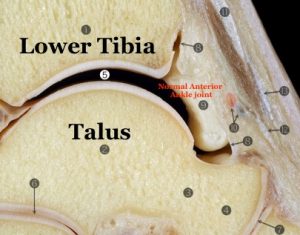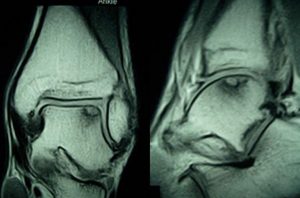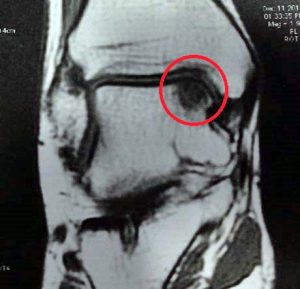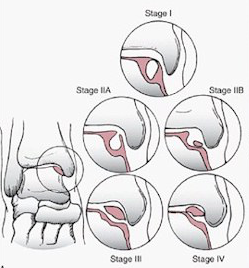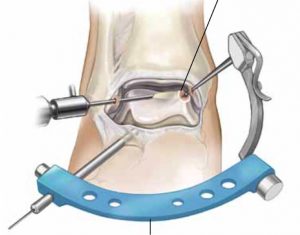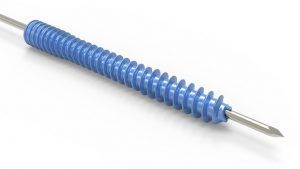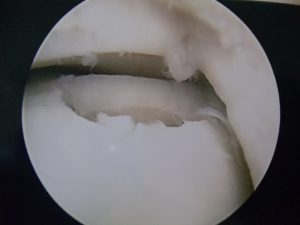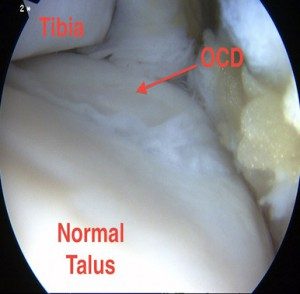Orthopaedics 360
“A Place to Learn”
Localised ankle cartilage damage is frequently seen in two regions of the talus. This lesion is termed an osteochondral defect (OCD). The two most common locations are:
- Anterolateral
- Posteromedial
Ankle Joint Anatomy
The ankle joint itself is made up of the two bones in the lower leg (tibia and fibula) and the talus (large bone that connects to both the tibia and fibula). The talus is a unique dome shaped bone. No muscles attach to the talus, and it has the highest percentage of articular cartilage coverage of any bone in the body, approximately 60% of its surface area.
When ankle cartilage damage occurs, this commonly affects the ‘articular’ cartilage of the talus
Common locations for Ankle Cartilage Damage
Anterolateral Talus
This lesion is located in the outer front area of the talus dome. This usually occurs due to an inversion and dorsiflexion injury where this region of the talus cartilage ‘impacts’ against the fibula, resulting in the damaged cartilage.
Posteromedial Talus
This lesion is located in the inner back area of the talus. While this represents a more common location for an OCD, the association with an injury is less consistent.
Common Symptoms
Do you have any of these
Classically patients experience pain, swelling, locking, and swelling of the ankle joint.
Anterolateral Lesion
These lesions are more likely to be secondary to an acute twisting injury of the ankle. They can frequently be missed on plain xrays, given the subtle appearance. Patients often experience ongoing pain over the outer (lateral) aspect of the ankle joint, with a persistent ‘catching’ sensation and swelling. Difficulty with activities, and walking on uneven ground is also experienced.
Posteromedial Lesion
These lesions are more common than the ‘Anterolateral’ location. A discrete injury has not always occurred. Pain on the inside (medial) of the ankle joint, with catching and clicking, and swelling can be experienced.
‘Staging’ the Cartilage Lesion
Important for treatment options
There are 4 main stages to the condition and each requires different treatment.
Stage 1
Articular cartilage is intact. May be presence of subchondral (below the joint) compression fracture
Stage 2
Lesion is partially detached from its origin
Stage 3
Lesion is completely detached but remains in the same approximate position.
Stage 4
Lesion is completely detached and has moved to another part of the ankle joint
Ankle Cartilage Lesions require a detailed assessment
Treatment of localised Ankle Cartilage damage
The management of localised ankle cartilage damage, talar OCD, is complex. Early stages of the condition may be managed conservatively with restriction in weight bearing and boot/cast immobilisation. If these measures fail, or in the setting of an ‘unstable’ lesion, then operative management is warranted.
Stage 1
‘Drilling’ of the lesion may be performed to help stimulate blood flow to the area and healing. This can usually be done via a keyhole arthroscopy.
Stage 2
Depending on the size of the lesion at arthroscopy, a decision is made as to whether to excise the unstable fragment, versus attempt fixation with small ‘pins’
Stage 3
Assessment of the lesion is required via an arthroscopy. All attempts are made to fixate the unstable lesion with the use of small screws/pins.
Stage 4
This is the most severe form of the condition, and it is not always possible to repair the injured cartilage. In this setting, other cartilage restoration techniques need to be considered.
Keyhole Assessment and management of Talus cartilage lesions
An arthroscopy provides us with the most reliable information regarding the severity of your cartilage lesion and allows us to tailor your management.
Want a detailed assessment of your ankle?
Ankle sprains and arthritis
People don’t generally tend to associate ankle sprains with ankle arthritis due to its seemingly innocuous presentation in comparison to ankle fractures or dislocations, however recurrent ankle sprains can result in serious trauma to the ankle. Post traumatic...
A seemingly simple ankle sprain can lead to ankle arthritis
Ankle arthritis is less common that Hip and Knee arthritis. In fact, while Hip and Knee arthritis is commonly attributed to genetics and ‘wear and tear’ with increasing age, the ethology of ankle arthritis is often quite different. The most common cause for someone...
Ankle Impingement
Ankle impingement is a common cause of ankle pain. We discuss what causes ankle impingement here.
Disclaimer: Please note that this is general advice only - for more information, please consult your regular doctor, or obtain a referral to see a specialist orthopaedic surgeon.
Orthopaedics 360
Orthopaedics 360
P: (08) 7099 0188
F: (08) 7099 0171
Southern Specialist Centre
Orthopaedics 360
P: (08) 7099 0188
F: (08) 7099 0171
Health @ Hindmarsh
Orthopaedics 360
P: (08) 7099 0188
F: (08) 7099 0171

